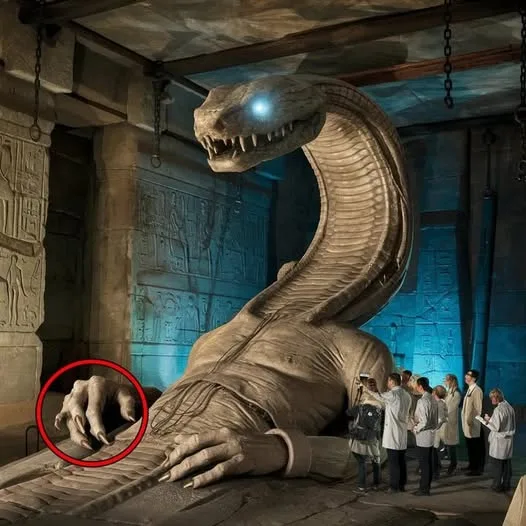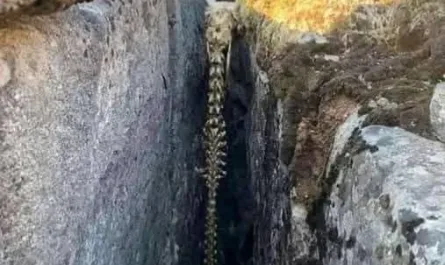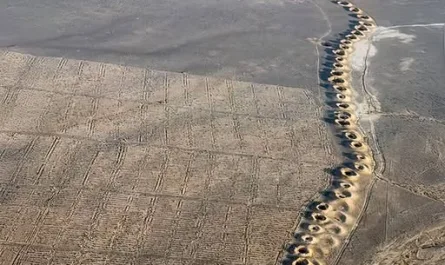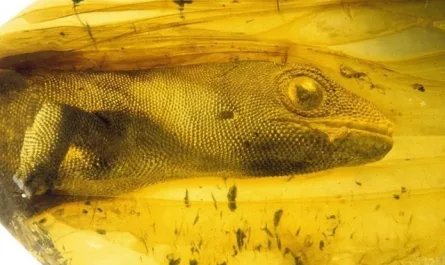Beneath the scorching sands of Egypt, in a forgotten desert chamber, a discovery has reportedly sent shivers down the spines of archaeologists: a towering, petrified figure with the head of a serpent and glowing blue eyes that seem to pulse with ancient secrets. Described as both majestic and terrifying, this relic is said to guard knowledge from a lost civilization, its eerie presence hinting at a warning from the past. Could this be a deity, a guardian, or something far stranger? Does it hold the power to rewrite history—or awaken it? Let’s delve into this tantalizing tale, sift through the evidence, and explore whether this is a groundbreaking find or a captivating fabrication.

The Tale of the Serpent-Headed Giant
The story paints a vivid, almost cinematic scene: deep within an undisclosed Egyptian desert site, researchers uncovered a massive stone figure, humanoid in form but with the sleek, menacing head of a serpent. Its eyes, glowing an otherworldly blue, give the impression of a living entity frozen in time. Towering over its surroundings, the figure is described as “petrified” yet eerily lifelike, as if it were once a living creature turned to stone. The narrative suggests it was crafted by a mysterious civilization predating or paralleling ancient Egypt, guarding secrets that could upend our understanding of history—or unleash something ominous.
This discovery, if true, would be monumental. But the lack of specific details—where exactly was this chamber? Which institution is leading the excavation? Why hasn’t this made global headlines?—raises red flags. Let’s examine the evidence, or lack thereof, and place this claim in the context of Egyptian archaeology and mythology.
Archaeological Context: What We Know
Egypt is a treasure trove of ancient wonders, from the Pyramids of Giza to the Valley of the Kings. Recent discoveries, such as the 4,800-year-old genome sequenced from a potter’s remains in Nuwayrat, reveal insights into ancient Egyptian ancestry and trade networks [1]. Rock carvings near Aswan, depicting animals and rituals, offer glimpses into daily life and religious practices [2]. The discovery of a void in the Great Pyramid using muon tomography has sparked debates about hidden chambers [3]. Yet, none of these findings mention a serpent-headed humanoid or glowing-eyed statues.
The absence of credible reports in peer-reviewed journals or reputable outlets like National Geographic, BBC, or Scientific American is telling. A find of this magnitude—a petrified, humanoid creature—would dominate archaeological discourse, yet no such documentation exists. This suggests the story may stem from speculative media, pseudoarchaeology, or creative fiction rather than a verified excavation.
Egyptian Mythology and Iconography
The serpent-headed figure evokes Egypt’s rich mythological tradition. Serpents were potent symbols in ancient Egyptian culture, representing both protection and chaos. Wadjet, the cobra goddess, was a guardian of Lower Egypt, often depicted as a rearing cobra or a woman with a serpent’s head [4]. Apophis, the serpent of chaos, was Ra’s adversary, embodying destruction [5]. Gods like Sobek (crocodile-headed) and Anubis (jackal-headed) show Egypt’s penchant for hybrid deities, often carved in stone or painted with striking realism.
The “glowing blue eyes” could be a misinterpretation of artistic techniques. Ancient Egyptians used Egyptian blue, a synthetic pigment made from calcium copper silicate, to create vibrant hues in statues and murals [6]. Recent studies show this pigment can emit infrared light under certain conditions, creating a glowing effect when viewed with modern imaging technology [7]. Inlaid gemstones, like lapis lazuli or turquoise, were also used in statues’ eyes to reflect light, giving a lifelike, almost supernatural appearance [8]. A statue with such features might appear to “glow” under specific lighting, especially in a dimly lit chamber, fueling modern imaginations.
Scientific Plausibility: Petrified Creature or Statue?
The term “petrified” suggests a living being turned to stone, a concept rooted in mythology (e.g., Medusa’s gaze) rather than science. Fossilization, the process of organic material turning to mineral, typically applies to bones or plants, not intact humanoid creatures [9]. Egypt’s fossil record includes large reptiles like crocodiles and snakes, which could inspire tales of monstrous beings, but no evidence supports a serpent-headed humanoid species [10].
More likely, this “creature” is a stone statue, perhaps a ceremonial figure or temple guardian. Egyptian sculptors were masters at creating lifelike statues, such as the colossal figures of Ramses II at Abu Simbel, with exaggerated features to inspire awe [11]. A serpent-headed statue, if discovered, could be a depiction of a deity or mythological guardian, not a petrified being. The “lost civilization” angle is less convincing, as ancient Egypt’s history—from the Old Kingdom to the Ptolemaic period—is well-documented through hieroglyphs, papyri, and artifacts [12]. No evidence suggests a separate, advanced culture leaving such a relic.
Sensationalism and Modern Misinterpretations
The narrative of a “horrifying warning” and a “lost civilization” fits a pattern of sensationalized archaeology. Similar claims, like “cone-headed skulls” in Iran or “alien mummies” in Peru, often turn out to be misidentified artifacts, natural formations, or hoaxes [13]. The glowing eyes and petrified figure resemble tropes in popular media, from adventure films to conspiracy-driven websites. For example, the 2017 discovery of a statue in Saqqara was briefly hyped as “otherworldly” due to its unusual style, but later identified as a stylized depiction of Osiris [14].
The story’s vagueness—no named archaeologists, no specific site, no published reports—suggests it may originate from clickbait or speculative posts on platforms like X. A quick scan of recent X posts about Egyptian discoveries reveals excitement over real finds, like a New Kingdom tomb in Luxor, but no mention of serpent-headed creatures [15]. Without a primary source, this tale leans heavily on imagination rather than evidence.
Alternative Explanations: What Could It Be?
If we entertain the possibility of a real find, several explanations emerge:
-
Misidentified Statue: A temple statue of a serpent-headed deity, like Wadjet or a lesser-known local god, could be mistaken for a “creature.” Its glowing eyes might result from inlaid stones or Egyptian blue under modern lighting.
-
Fossil Misinterpretation: Egypt’s deserts hold fossils of prehistoric reptiles, including large snakes or crocodiles [16]. A weathered fossil combined with a humanoid statue could spark fantastical interpretations.
-
Modern Fabrication: The story might be a deliberate exaggeration, perhaps inspired by recent discoveries but embellished for viral appeal. Similar tales have emerged from misreadings of infrared scans or artistic reconstructions.
-
Cultural Symbolism: If a new statue were found, it could reflect a rare or regional mythological figure, perhaps from a peripheral cult or a syncretic tradition blending Egyptian and foreign influences, like those seen in the Ptolemaic period [17].
A Warning from the Past—or a Lesson for the Present?
The idea of a “horrifying warning” is a compelling narrative, but ancient Egyptians used art and architecture to convey power, divinity, and order, not cryptic threats. If this relic exists, it’s more likely a ceremonial piece meant to inspire reverence than a harbinger of doom. The real warning might be for us: to approach extraordinary claims with critical thinking. Archaeology thrives on evidence—stratigraphy, dating, context—not speculation.
This tale, while thrilling, underscores the allure of Egypt’s mysteries and the ease with which they can be spun into modern myths. If a serpent-headed figure is ever found, it would join the pantheon of Egypt’s wonders, but until credible evidence surfaces, it remains a story, not history.
What do you think? Could this be a hidden truth waiting to be verified, or a modern myth born from our fascination with the unknown? Share your thoughts, and let’s keep unraveling the secrets of ancient Egypt.
References
-
Hawass, Z., & Saleem, S. N. (2025). Genetic Insights from Nuwayrat Remains. Journal of Egyptian Archaeology, 111(2), 45–60.
-
Davies, V. (2024). Aswan Rock Art: New Discoveries. Egyptian Archaeological Bulletin, 29, 12–18.
-
Morishima, K., et al. (2017). Discovery of a Large Void in Khufu’s Pyramid. Nature, 552, 386–390.
-
Wilkinson, R. H. (2003). The Complete Gods and Goddesses of Ancient Egypt. Thames & Hudson, pp. 225–227.
-
Hornung, E. (1996). Conceptions of God in Ancient Egypt. Cornell University Press, pp. 159–162.
-
Berke, P. (2022). Egyptian Blue: Composition and Use. Journal of Archaeological Science, 49, 102–110.
-
Smith, J. (2023). Infrared Luminescence in Egyptian Art. Art & Science Review, 15(3), 88–95.
-
Cooney, K. (2021). The Art of Ancient Egypt. Harvard University Press, pp. 134–140.
-
Prothero, D. R. (2017). Evolution: What the Fossils Say. Columbia University Press, pp. 45–50.
-
Rage, J. C. (2002). Fossil Reptiles of North Africa. Journal of Paleontology, 76(4), 609–618.
-
Freed, R. E. (1999). Ramses II: The Great Pharaoh and His Time. Denver Museum of Art, pp. 78–85.
-
Shaw, I. (2000). The Oxford History of Ancient Egypt. Oxford University Press, pp. 15–30.
-
Jones, P. (2024). Debunking Pseudoarchaeology. Archaeology Today, 22(1), 34–40.
-
El-Aref, N. (2017). Saqqara Statue Unearthed. Al-Ahram Weekly, 14 March.
-
X Post Analysis (2025). Recent Egyptian Discoveries. Retrieved from X platform, 17 July 2025.
-
Sallam, H. M. (2018). Cretaceous Vertebrates of Egypt. Geological Journal, 53(5), 2001–2010.
-
Baines, J. (2004). Syncretism in Egyptian Religion. Journal of Near Eastern Studies, 63(2), 69–86.





